Palm Washingtonia got its name in honor of the first president of the United States, George Washington. This genus is a representative of the Arecaceae family and unites only 2 species, namely: Washingtonia strong and Washingtonia thread-bearing.
Content
Features of washingtonia
Washingtonia palm is a tree that can reach about 25 meters in height and up to one meter in diameter. However, it reaches this size only in natural conditions. At the top of the trunk, leaf plates grow, which have a fan shape. The length of the petiole is about one and a half meters, it has thorns that are directed towards the trunk. When grown at home, the palm tree blooms very rarely.
In Mexico and the United States, the fibers of the foliage of this palm tree are used for weaving baskets, and flour is made from its fruits. In culture in Europe, it is grown on the southern Mediterranean coast. When cultivated in indoor conditions, it should be borne in mind that this plant needs coolness, as well as space. After the palm tree has become very large, it is recommended to move it outside, but only if the weather conditions are favorable for this.
Brief description of cultivation
- Bloom... Palm Washingtonia is cultivated as an ornamental leafy plant.
- Illumination... The plant needs a lot of bright light, which must be necessarily diffused. Daylight hours are about 16 hours. In winter, it needs additional lighting.
- Temperature regime... In the spring-summer period - from 20 to 24 degrees (no higher), in winter - about 10 degrees.
- Watering... In the spring-summer period, the soil mixture in the container is moistened after its surface dries out. In the cold season, watering should be very scarce and rare, but overdrying the earthy coma should not be allowed.
- Air humidity... It should be elevated. During the growing season, foliage is moistened twice a day, and it also needs to be washed with a damp sponge once every 7 days. To increase the humidity of the air, you can put open vessels filled with water near the palm tree. In winter, the plant cannot be moistened.
- Fertilizer... It is necessary to feed Washingtonia from spring to autumn regularly once every 15 days, it is recommended to use fertilizer with a high iron content.In the cold season, you do not need to feed the palm tree.
- Dormant period... It begins in late autumn and ends in the first weeks of spring.
- Transfer... In spring, plants are transplanted only when necessary. Until the palm tree is seven years old, it is transplanted 1 time in 2 years, up to fifteen years old - 1 time in 3 years, and a more mature plant - 1 time in 4-5 years.
- Soil mixture... It should consist of peat (or humus), sand, leafy and soddy soil (2: 1: 2: 4).
- Reproduction... Grown from seeds.
- Harmful insects... Scabbards, whiteflies, spider mites and mealybugs.
- Diseases... Rot may appear on the root system due to violation of watering rules or if there is no drainage in the container. If the air in the room is excessively dry, the tips of the leaf plates begin to dry out.
Caring for washington at home
Illumination
Most often, flower growers are mistaken in the fact that the washingtonia palm needs a lot of bright light. However, it should be remembered that the plant must be protected from direct sunlight. The light should be bright, but diffused, while the duration of daylight hours should be at least 16 hours a day. For growing palm trees, it is recommended to choose an east or west orientation. In the cold season or when the light day is not long enough, the plant is provided with additional lighting, for this you can use fluorescent lamps.
In the summertime, Washington is recommended to be moved to the street, a well-lit place is chosen for it, but it must be protected from direct sunlight, as well as from rain. The room where the plant is located must be regularly ventilated, but at the same time it must be protected from drafts. It needs a lot of light both in summer and in winter.
Temperature regime
In the spring and summer, the indoor temperature can vary from 20 to 24 degrees. If the room is very hot (about 30 degrees and higher), then the palm tree needs to be moved to a place where it is cooler. Wait until it cools down, then water and moisten it with a spray bottle. In winter, the room should be cool (about 10 degrees). There is no need to worry that at such a low temperature, the palm tree may not die, since in the wild in its homeland it is able to withstand a short-term temperature drop to minus 7 degrees.
Watering
During the growing season, watering is carried out systematically immediately after the top layer of the soil mixture in the container dries out. Remember that both stagnant liquid in the substrate and overdrying of the earthy coma are equally harmful for Washington. In the autumn, after the palm tree begins a dormant period, and it is moved to a cooler place, they rarely begin to moisten the soil mixture in the pot and use a small amount of water for this. However, it is impossible to allow overdrying of a lump of earth. As a rule, at this time, watering is carried out two or three days after the top layer of the earthen mixture dries out. For irrigation, use warm and well-settled (at least 24 hours) water.
Air humidity
For a palm tree to develop and grow within normal limits, it needs to provide high humidity in the room. In this regard, it must be moistened every day from a sprayer (preferably twice a day), and it is also recommended to place an open vessel filled with water next to it. It is also necessary to regularly remove dust from the surface of the foliage using a damp soft cloth or sponge.
Fertilizer
Such a plant, cultivated in indoor conditions, must be fed regularly. Fertilizers are recommended for use with a high iron content. Top dressing is carried out from spring to autumn 1 time in half a month.Fertilizers cannot be applied to the substrate throughout the rest period, and even immediately after transplanting the bush and when Washingtonia is sick.
Pruning
Experienced flower growers recommend removing the yellowed leaf plate even before it dries completely. Due to this, there will be a slight slowdown in the natural dying off of the next sheet plate. In the event that you decide not to remove the drying foliage, then you can not cut it at all. In this case, dried leaves will hang effectively around the trunk.
Washingtonia transplant
Washingtonia is transplanted only when absolutely necessary. The fact is that she does not tolerate transplants quite well, and it takes her some time after this procedure to settle down. At this time, there is a slight slowdown in growth. Until the age of seven, a palm tree is transplanted once every 2 years, at 8-15 years old - once every 3 years, and older specimens are subjected to this procedure every 4-5 years.
Transplant the plant in the spring before summer comes. Early spring is best suited for this. Since Washingtonia is a rather large plant, tubs made of wood are suitable for growing it. A suitable soil mixture should consist of leafy, turf and peat (or humus) soil, as well as sand (2: 4: 2: 1). It is recommended to add organic matter (about 5 kilograms) to the soil mixture for adult palms. If, during the growth of the plant, its roots are exposed, then it will be necessary to pour fresh soil mixture into the tub.
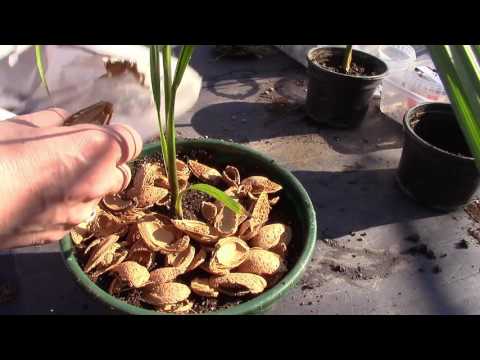

Watch this video on YouTube
Growing from seeds
The Washingtonia palm tree is propagated at home by seeds. Sowing is carried out in the spring, or rather, from March to April. Fresh seeds have the highest germination rate, therefore it is recommended to use them for sowing. Remember that the older the seed, the more time it takes to germinate and the lower its germination rate.
Immediately before sowing, it is recommended to file the seeds slightly with a file, after which they are immersed in water for 24 hours. The seeds are sown in a substrate consisting of sand, sphagnum and sawdust (1: 1: 1), to which a little charcoal is added. The seeds are buried in the soil mixture by only 10 mm. Before you start preparing the soil mixture, be sure to steam the sawdust. Moisten the crops and cover them with glass (film) on top. Transfer the container to a warm place (28 to 30 degrees). In the event that everything is done correctly and using fresh seed, then the first seedlings should appear in 15-20 days.
The picking of seedlings is carried out after 7 days have passed after the formation of their first true leaf plate. For picking, a separate cup is used, which is filled with a soil mixture consisting of sand, leafy and soddy soil (1: 1: 2). The first leaf plates of the plants are not dissected; cuts appear only on the eighth or ninth leaf. After 1 year of growth, a young palm tree will already have 4–5 leaf plates. Do not forget that the dive must be done very carefully!


Watch this video on YouTube
Possible problems
If Washington is not properly looked after, then the following problems may arise with it:
- Decay of the root system... Rot appears as a result of regular stagnation of liquid in the soil mixture. There may be no drainage in the tub or it is very poor.
- Flying around foliage... If the air humidity is very low, the palm tree begins to shed its foliage.
- The tips of the leaves turn brown... This problem is also associated with excessively low air humidity.
- Harmful insects... Most often whiteflies, mealybugs, scale insects or spider mites settle on the palm.
Types of washingtonia with photos
Washingtonia filifera
This species comes from the eastern part of the United States of America.In nature, palm trees can reach about 20 meters in height. The trunk is straight and even, and at its top, grayish-green leaf plates of a fan-shaped shape grow. A third of the dissected leaf plates reach about 200 cm in length, about 80 lobes are formed on each of them. Long white threads grow at the edge of the foliage. The color of the flowers is white.
Washingtonia robusta
Or Washingtonia robusta, or Washingtonia sonorae. The height of such a tree-like perennial plant in nature reaches about 30 meters. Greenish leaf plates are fan-shaped. The foliage is cut into 2/3 of the length of the plate. The petiole is painted in a pale red shade. The flowers are white.
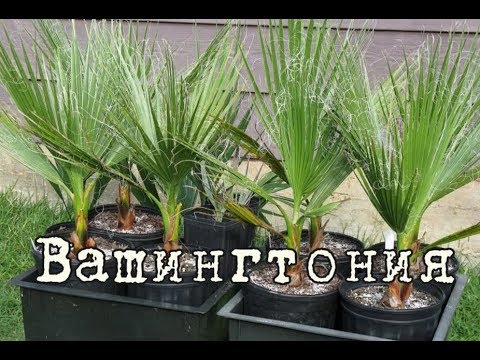

Watch this video on YouTube

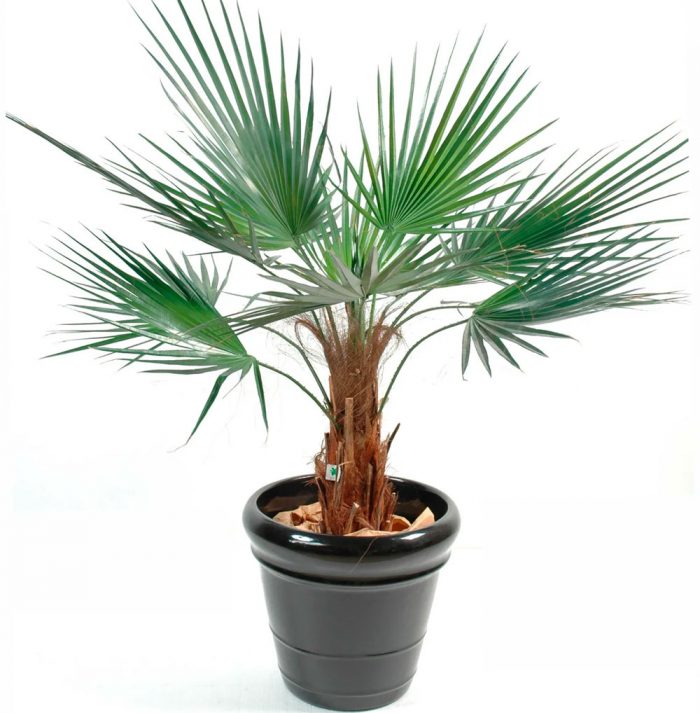
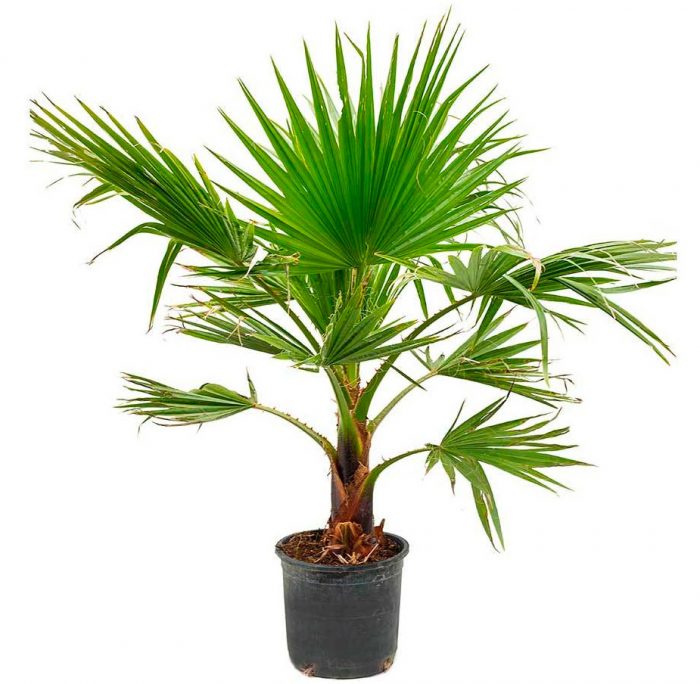
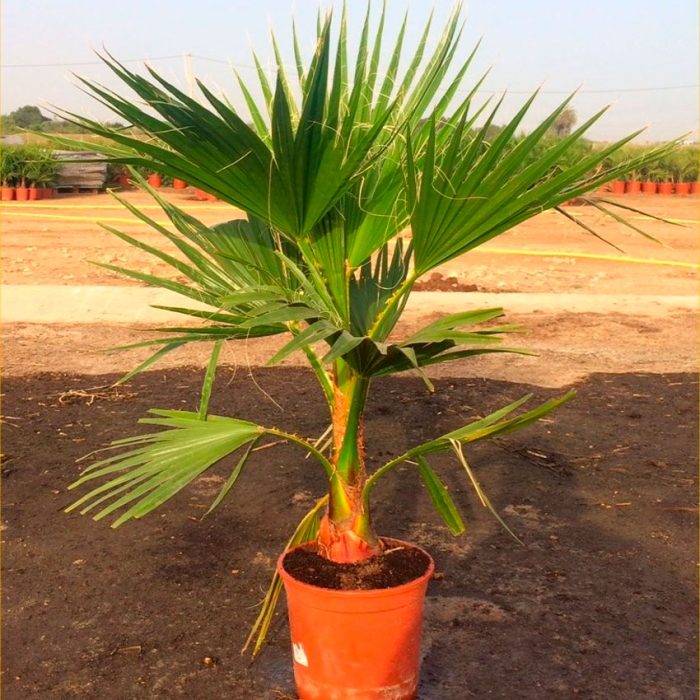
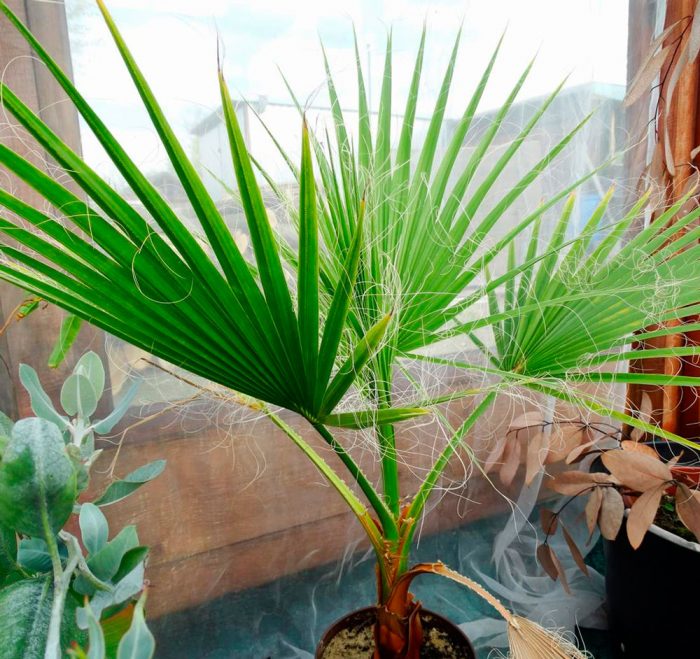
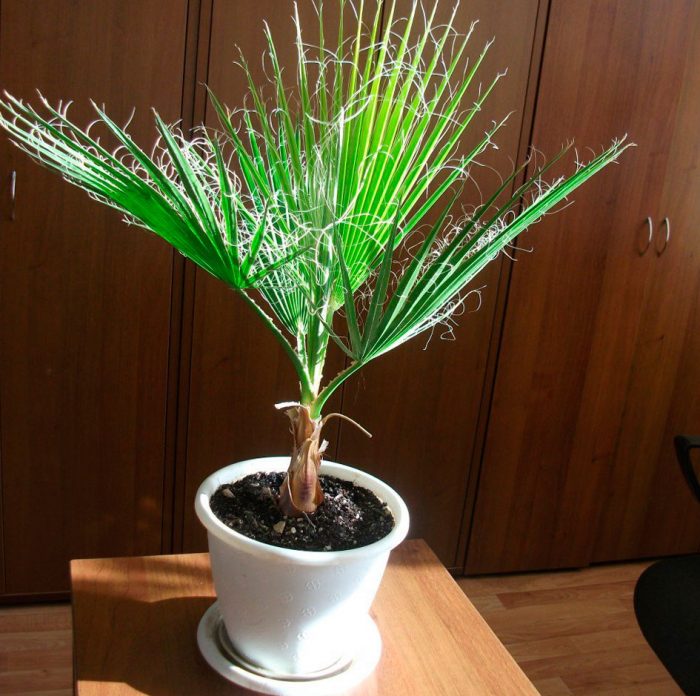
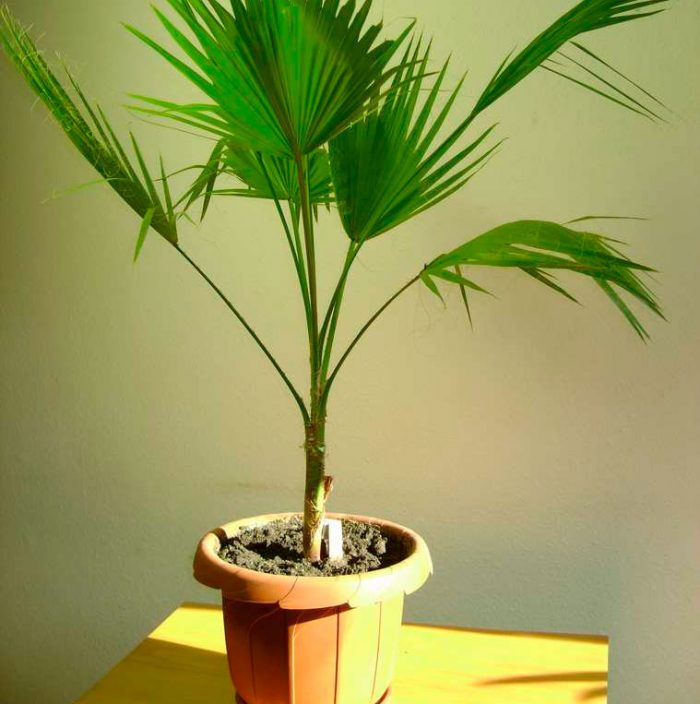
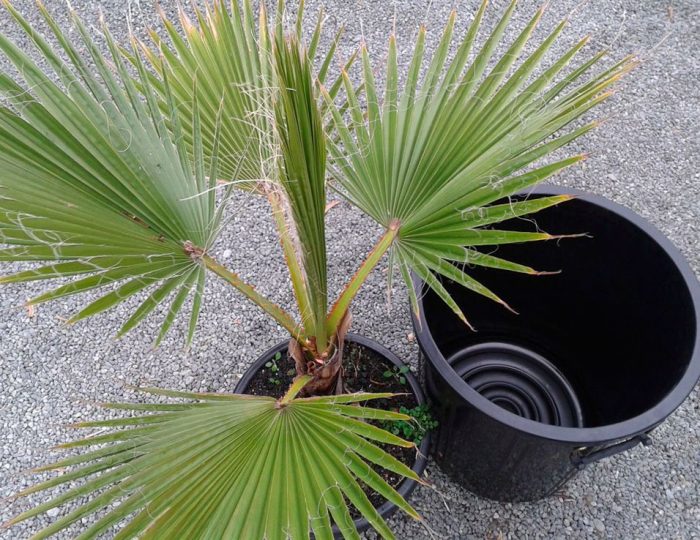
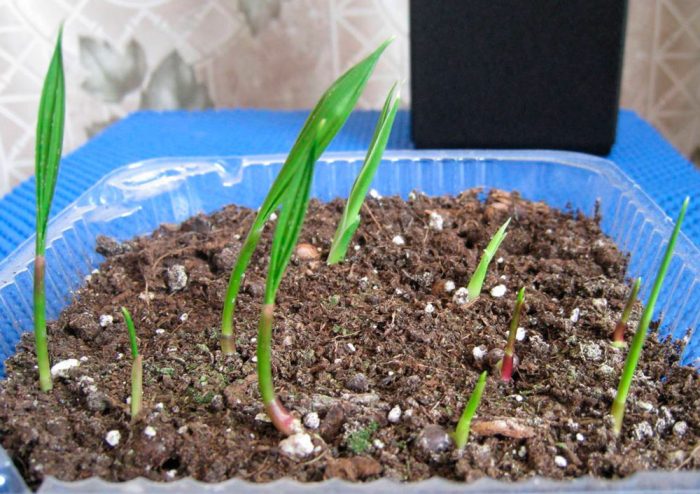
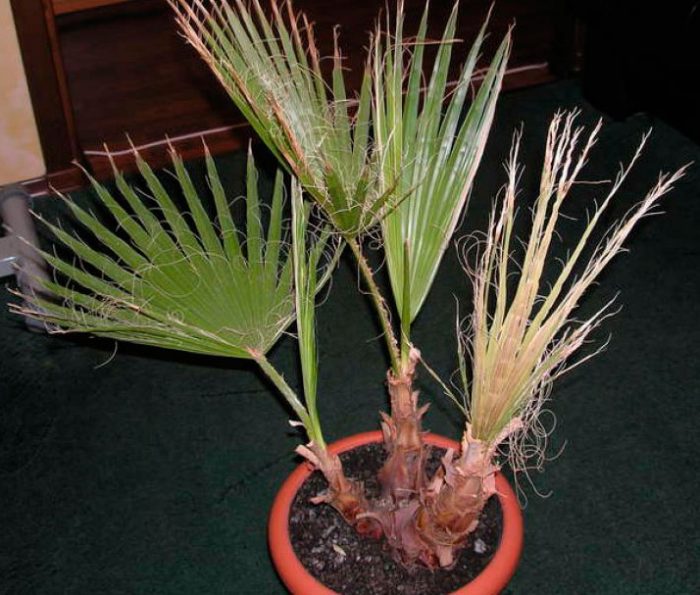
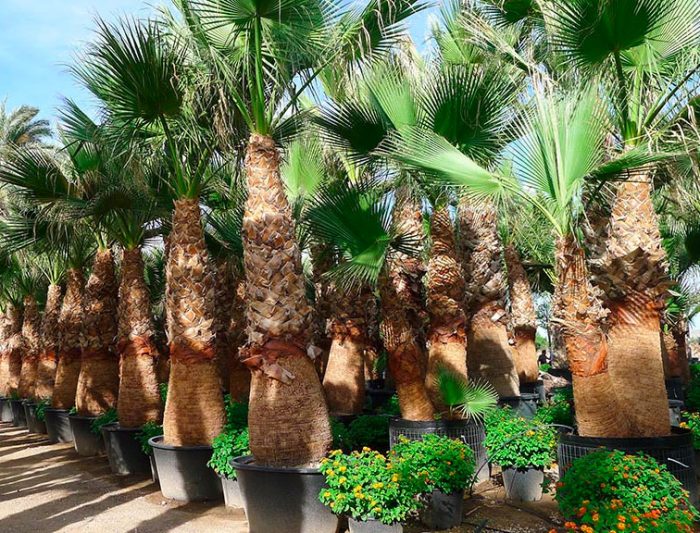



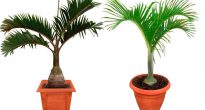


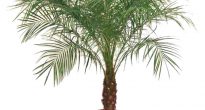


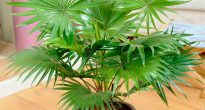

Please tell me what kind of palm tree, if it grew for several years, about 35, during this time it grew by a meter in height, the trunk with scales, thick, about 6 cm, elongated green stems at the top of the trunk and dark leaves on the stems, the leaves are not sharp, the shape of the leaves like oak, strongly elongated. That is, the leaves are oblong and rounded at the tips and have a wavy shape rather than sharp. It grows in a large pot, at home.
My Washingtonian palms stopped growing, and at the same time. The leaves turned yellow and fell off. Watering was moderate, I have been growing for four years already, transplanted into larger pots and after transplanting they gave new leaves well, but their "mood" was not as happy as in the previous pots. All winter it was normal, but by the spring there was such a problem. I did not notice the pests, there were no cobwebs and powdery plaque. I was afraid that maybe the roots don't like something. I dug them out - the roots are dry, but the watering was normal, the earth is lush, not lumpy. I put them in a weak solution of potassium permanganate, and I think what to do now?
Help advice, who knows.